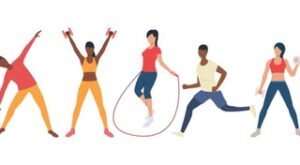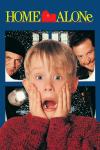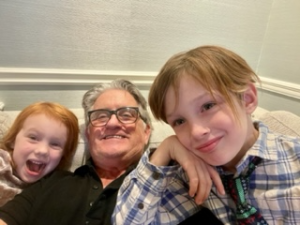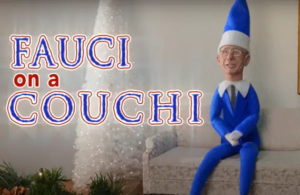Re the Bill Maher video in Tuesday’s P.S.:
“My pet peeve on stupid woke word term requirements is that it is now
inappropriate to say homeless and you must say ‘unhoused.’ I think whoever came
up with this one is ‘unsmart.’” – PL
Re the Bill Maher video in Tuesday’s P.S.:
“My pet peeve on stupid woke word term requirements is that it is now
inappropriate to say homeless and you must say ‘unhoused.’ I think whoever came
up with this one is ‘unsmart.’” – PL
The best science images of 2022 from the Nature website…
Click here to see an almighty eruption, the cosmos remastered, swirling cells, and more.
A Fitness Program for 2023
Good for the Young as Well as the Older

Since my stroke three months ago, I’ve been trying to get back into my former physical shape. I want to reclaim my strength, speed, flexibility, and stamina – the things that make it possible to play Brazilian Jiu Jitsu. Enjoying my favorite sport is a good reason to get fit again. But a better reason, thanks to surviving the stroke, is the recognition that achieving certain levels of physical performance health should not only extend but also enhance the quality of my life.
I’ve been reading about and reporting on fitness and longevity regularly since early 2000. In that time, there has been an unending stream of studies on those topics with a variety of findings. (As you might expect.) But of everything I’ve read, including many meta-studies, there are two objectives that matter more than any of the others.
They are not, as one might expect, those things that one notices most about aging: the diminishing flexibility, stamina, and balance. Those are important. But the studies show that the thing that matters most is strength: muscular strength, skeletal strength, and the strength of the heart and lungs.
If you are younger than 50, my approach to exercise may be similar to the one you are doing now. I exercise all the muscle groups and my lungs pretty hard. People 50 and over are typically advised to (or feel comfortable with) exercise that is less intense. When it comes to training my heart, my approach would have been considered radical for anyone over 40 and downright dangerous for anyone in his 70s. And many doctors and fitness experts that are not familiar with all the recent studies (like the one below) would have that view today. So, find someone that you trust, who is also up to date on fitness studies, to advise you personally.
My exercise routine is based on the notion that to make your body stronger – and that includes not only your muscles but your skeleton, your heart, and your lungs – you have to stress it by pushing yourself harder than you probably want to. It means lifting more weight, sprinting faster, and generally pushing yourself towards exhaustion.
This is what I do:
Although I schedule six hour and a half workouts a week, I do fewer than that at least one week a month. Four of those sessions are doing Brazilian Jiu Jitsu. The way I train (hard for an hour of the 90 minutes), it exercises my entire body, inside and out, and leaves me exhausted. Two days a week I do a physical fitness training. This consists of about 40 to 50 minutes of heavy and intense weightlifting, 20 minutes of intense cardiovascular exercise (usually four 5-minute bike sprints), and 20 to 30 minutes of stretching.
My goal in weightlifting is to exhaust my muscles. That means lifting like a power lifter or an Olympic lifter (hard and fast), rather than a body builder (less weight and more control). And I try to get stronger, either in terms of maximum strength or stamina.
My goal in cardiovascular exercise is to do at least three bike sprints (on an Aerodyne bike) in 30 minutes. Given the condition of my knees these days, it’s tough. (Believe me!) I don’t do a single five-minute ride at a moderate pace. I sprint as hard as I can for 15 seconds, continue at a moderate rate for 10 seconds, and repeat. I monitor my heart while I bike. My goal is to get my heart to its maximum level, which in my condition these days is about 170 beats.
If I have a good workout:
* I will have achieved a heart rate of 170 beats at least once.
* I will feel physically exhausted – like I could not climb a flight of stairs.
* I will have sweated off at least 2% of my body weight – i.e., more than four pounds.
* I will feel very good.
Unless I have business or family requirements that make it impossible, I am pretty good about finding time to exercise six times a week. But I can’t say that I achieve the goal of exercising to exhaustion every time.
In fact, it’s not unusual – and lately, it’s quite common – for me to walk into my gym with a head full of reasons why my trainer should take it easy on me. I don’t beat myself up about this impulse to shirk the work. I accept it as a natural and inevitable product of getting older. But what has been working for me is that I’ve told my trainers to agree with whatever BS I tell them and get me moving slowly at first… and then gradually push me as hard as I’ll go for the rest of the time.
If you don’t have a trainer, that will be more difficult. But you can still do it. Just start off easy and increase the pace and intensity gradually. As your body warms up, you will find that you can do more than you might believe.
Yet Another Finding That “Short Bursts of Activity Lower Your Risk of Early Death”
Just after I finished writing the above essay, a friend sent me the results of a new study – another one showing that exercising the way I do produces better results than longer sessions of low-to-moderate intensity. Read the details here.
(My friend’s business, by the way, is Naturecast Products. If you’d like to know more about it, and receive their free newsletter, you can check it out here.)

This is an essay I wrote that was published on Dec. 19 by DIY Wealth – an online business that provides guidance on entrepreneurship, investing, and other aspects of building wealth. (Disclosure: I am an investor in that business.)
It starts like this:
You go to lunch with a colleague. Everything is good. When the waiter puts the bill on the table, the total is $26.
Do you pick it up? Do you wait and hope he does? Or do you suggest you split it?
On the surface, this is a minor decision. But in truth, it is one of a million chances you’ve had, have, and will have to become wealthier.
A cheapskate might look at it this way:
* If we split the bill, I’ll be $13 poorer.
* If I can get him to pay it, I’ll be $26 richer.
* If I pay the whole bill, I’ll be $26 poorer.
To the cheapskate, the best decision is obvious. So when the check arrives, he gets up to “go the bathroom,” hoping he’ll be $13 richer when he returns.
But I have a different view. For wealth building, like quantum mechanics, often operates according to laws that seem contrary to what is “obvious.”
Click here to read the rest of the essay.
“What have you found to be the best meeting rhythm for a copywriting team? Regular meetings to brainstorm on copy and ads? Meetings only when necessary to collaborate on new copy? As few meetings as possible and let the copywriters slave away in dark rooms? I appreciate your insights. (And great to see you still writing regularly. I read everything you put out.)” – CB
My Response: I haven’t formally thought about a “meeting rhythm” for copywriters. Or written about it. But what I’ve done, when working with teams, is have lead-storming meetings once a quarter or twice a year or annually, depending on scheduling needs.
Here’s how they work…
The meetings are tape-recorded.
Within 24 hours of a decision to go with a particular lead, the copywriter must produce a 500+ word first draft. I don’t like waiting more than a day for the first draft, because I’ve found that it’s easy to forget the cleverness of the core idea behind the lead. The core idea is more than just an idea. It’s the emotion behind it. It’s the wording. If you wait too long – say, a couple of weeks – the core idea will be gone. Even if everyone thinks they remember it. (Thus, the tape-recording.)
If the first draft is approved by the team, the next step is a second draft. Longer and more detailed. Usually about 1,000 to 1,500 words. Again, the copywriter must produce it within 24 hours.
Once that is approved, the team agrees to a deadline for the first draft of the full promo, sometimes including intermediate deadlines.
I think four weeks is the right amount of time for completing the first draft of a full promo, from idea generation to completion. I would not allow any more than that.
And then the rewrite begins. Depending on the suggestions given to the copywriter, the final draft should take no more than two weeks.
As far as working in solitude vs. in physical proximity with other copywriters is concerned, there is an obvious advantage to being surrounded with other writers. At the same time, many creative people find that working with others around is distracting. Considering the way so many people are working remotely today, I’d leave the writing itself decision up to the copywriters individually. But I would mandate that all the brainstorming and the team reviews be done in person.
There are few things more annoying than talking to someone that can’t stop talking about how clever and cute their little child or grandchild is.

It’s understandable as a biological impulse – protection of the gene pool, and all that. But it’s not good manners. And face it, nobody wants to hear about it.
Unless…
… unless the child is truly extraordinary, exceptionally clever, and almost unbelievably adorable. Like my grandson, Hudson (above).

Home Alone
Directed by Chris Columbus
Written by John Hughes
Starring Macaulay Culkin, Joe Pesci, Daniel Stern, John Heard, and Catherine O’Hara
Released in theaters Nov. 16, 1990
Currently streaming on Disney+
Last Monday, after dinner, I cuddled up with two of my grandkids, Francis (6) and Willa (4), to watch a Christmas movie of their choosing.

I was surprised by what they picked: Home Alone. The original version.
Of course, I’d seen it several times before. But this was the first time I realized that Macaulay Culkin is not just the main character, he’s by far the central character. He’s in almost every scene. And I was reminded of how amazingly good he was. (He was 10 years old at the time.) His performance made what would have been a good movie into a great movie. I hope he got a share of the residuals. He certainly earned it!
If you’ve never seen Home Alone, you might be surprised to know that this beloved children’s movie is replete with violence. Not mild violence, but the sort that makes an adult wince. How to describe it? It’s fake. But real. It’s Laurel and Hardy plus the Three Stooges plus Wile E. Coyote. What little Kevin does to the adult thieves is illegal in about half a dozen ways. Like “Fauci on a Couchi” (see “Good to Know,” below), I would have thought it would scare Francis and Willa. It didn’t. They loved it!
Critical Reception
* “[Culkin] is a vivid screen presence, almost incandescent with confidence.” (Peter Bradshaw, Guardian)
* “Home Alone seems to be nominating itself as a Christmas classic [and] the film does go some way toward getting the job done.” (Dave Kehr, Chicago Tribune)
* “The whole thing is gloriously tinged with nostalgia.” (Patrick Smith, Daily Telegraph/UK)
You can watch the trailer here.

Children, like their taller counterparts, enjoy bright and funny stories. And when they like something – any form of entertainment – they want to experience it over and over again. This is how Homo sapiens learn. So, one has to be sensitive to what sort of entertainment one exposes them to.
Three years ago, I saw a video that was produced for the Jimmy Kimmel TV show. A lighthearted send-up of Anthony Fauci. (This was when the doctor was loved and trusted by nearly everyone.) I thought it was funny in a sort of sweet and gentle way. I also thought my grandkids might like it. But there was one scene I was concerned about – a scene where a child gets laser-demolished. I thought, “I should let their parents take a look at this and decide.” But I didn’t do that. I went ahead and showed it to them while their parents were out Christmas shopping.
And like the violence in Home Alone (see “Worth Watching,” above), it didn’t bother them at all. Since then, whenever they see “Daddo,” they ask for “Fauci on a Couchi.” Not just once, but at least two or three times a day. I’m sure my daughters-in-law are worried that I might be damaging their children’s brains. I hope I’m not. At least, not permanently.
By the way, “Fauci on a Couchi” has many fans. It might be the highest viewed YouTube video ever. It garnered 14 billion views in 2020, and billions more since then. And there’s a whole mess of “Fauci on a Couchi” paraphernalia that you can buy on Etsy. Click here.
In case you haven’t seen the video, you can watch it here.
And when you’re done watching it, quiz yourself: Can you count how many times Fauci gave bad advice in the clip? (Hint: It’s more than three.)